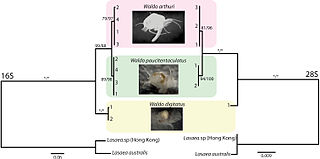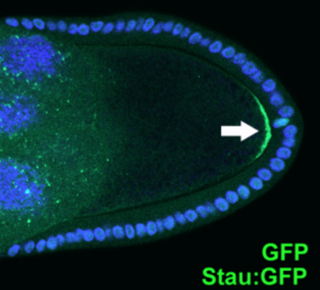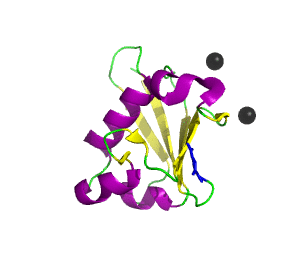Related Research Articles

Ribosomal DNA (rDNA) is a DNA sequence that codes for ribosomal RNA. These sequences regulate transcription initiation and amplification, and contain both transcribed and non-transcribed spacer segments.

An olfactory receptor neuron (ORN), also called an olfactory sensory neuron (OSN), is a sensory neuron within the olfactory system.
Transient receptor potential channels are a group of ion channels located mostly on the plasma membrane of numerous animal cell types. Most of these are grouped into two broad groups: Group 1 includes TRPC, TRPV, TRPVL, TRPM, TRPS, TRPN TRPA. Group 2 consists of TRPP and TRPML. Other less-well categorized TRP channels exist, including yeast channels and a number of Group 1 and Group 2 channels present in non-animals. Many of these channels mediate a variety of sensations such as pain, temperature, different kinds of tastes, pressure, and vision. In the body, some TRP channels are thought to behave like microscopic thermometers and used in animals to sense hot or cold. Some TRP channels are activated by molecules found in spices like garlic (allicin), chili pepper (capsaicin), wasabi ; others are activated by menthol, camphor, peppermint, and cooling agents; yet others are activated by molecules found in cannabis or stevia. Some act as sensors of osmotic pressure, volume, stretch, and vibration. Most of the channels are activated or inhibited by signaling lipids and contribute to a family of lipid-gated ion channels.
The transcriptome is the set of all RNA transcripts, including coding and non-coding, in an individual or a population of cells. The term can also sometimes be used to refer to all RNAs, or just mRNA, depending on the particular experiment. The term transcriptome is a portmanteau of the words transcript and genome; it is associated with the process of transcript production during the biological process of transcription.
Cross-linking and immunoprecipitation is a method used in molecular biology that combines UV crosslinking with immunoprecipitation in order to identify RNA binding sites of proteins on a transcriptome-wide scale, thereby increasing our understanding of post-transcriptional regulatory networks. CLIP can be used either with antibodies against endogenous proteins, or with common peptide tags or affinity purification, which enables the possibility of profiling model organisms or RBPs otherwise lacking suitable antibodies.

28S ribosomal RNA is the structural ribosomal RNA (rRNA) for the large subunit (LSU) of eukaryotic cytoplasmic ribosomes, and thus one of the basic components of all eukaryotic cells. It has a size of 25S in plants and 28S in mammals, hence the alias of 25S–28S rRNA.

RNA-Seq is a sequencing technique that uses next-generation sequencing (NGS) to reveal the presence and quantity of RNA in a biological sample, representing an aggregated snapshot of the cells' dynamic pool of RNAs, also known as transcriptome.

Cell polarity refers to spatial differences in shape, structure, and function within a cell. Almost all cell types exhibit some form of polarity, which enables them to carry out specialized functions. Classical examples of polarized cells are described below, including epithelial cells with apical-basal polarity, neurons in which signals propagate in one direction from dendrites to axons, and migrating cells. Furthermore, cell polarity is important during many types of asymmetric cell division to set up functional asymmetries between daughter cells.

Horizontal gene transfer (HGT) refers to the transfer of genes between distant branches on the tree of life. In evolution, it can scramble the information needed to reconstruct the phylogeny of organisms, how they are related to one another.
Edward Marcotte is a professor of biochemistry at The University of Texas at Austin, working in genetics, proteomics, and bioinformatics. Marcotte is an example of a computational biologist who also relies on experiments to validate bioinformatics-based predictions.
Christopher Boyce Burge is Professor of Biology and Biological Engineering at Massachusetts Institute of Technology.

V. Narry Kim is a South Korean biochemist and microbiologist, best known for her work on microRNA biogenesis. Her pioneering studies have laid the groundwork for the biology of microRNA and contributed to the improvement of RNA interference technologies.

Ubiquitin-related modifier-1 (URM1) is a ubiquitin-like protein that modifies proteins in the yeast ubiquitin-like urmylation pathway. Structural comparisons and phylogenetic analysis of the ubiquitin superfamily has indicated that Urm1 has the most conserved structural and sequence features of the common ancestor of the entire superfamily.

Kaang Bong-Kiun was born in Jeju-do, South Korea, on November 21, 1961. He is a professor of neuroscience in the Department of Biological Sciences of Seoul National University. He is a Fellow of the Korean Academy of Science and Technology and co-director of the IBS Center for Cognition and Sociality with Changjoon Justin Lee.

David Sankoff is a Canadian mathematician, bioinformatician, computer scientist and linguist. He holds the Canada Research Chair in Mathematical Genomics in the Mathematics and Statistics Department at the University of Ottawa, and is cross-appointed to the Biology Department and the School of Information Technology and Engineering. He was founding editor of the scientific journal Language Variation and Change (Cambridge) and serves on the editorial boards of a number of bioinformatics, computational biology and linguistics journals. Sankoff is best known for his pioneering contributions in computational linguistics and computational genomics. He is considered to be one of the founders of bioinformatics. In particular, he had a key role in introducing dynamic programming for sequence alignment and other problems in computational biology. In Pavel Pevzner's words, "[ Michael Waterman ] and David Sankoff are responsible for transforming bioinformatics from a ‘stamp collection' of ill-defined problems into a rigorous discipline with important biological applications."
John B. Hogenesch is an American chronobiologist and Professor of Pediatrics at the Cincinnati Children's Hospital Medical Center. The primary focus of his work has been studying the network of mammalian clock genes from the genomic and computational perspective to further the understanding of circadian behavior. He is currently the Deputy Director of the Center for Chronobiology, an Ohio Eminent Scholar, and Professor of Pediatrics in the Divisions of Perinatal Biology and Immunobiology at the Cincinnati Children's Hospital Medical Center.

John J. Tyson is an American systems biologist and mathematical biologist who serves as University Distinguished Professor of Biology at Virginia Tech, and is the former president of the Society for Mathematical Biology. He is known for his research on biochemical switches in the cell cycle, dynamics of biological networks and on excitable media.
Transcriptomics technologies are the techniques used to study an organism's transcriptome, the sum of all of its RNA transcripts. The information content of an organism is recorded in the DNA of its genome and expressed through transcription. Here, mRNA serves as a transient intermediary molecule in the information network, whilst non-coding RNAs perform additional diverse functions. A transcriptome captures a snapshot in time of the total transcripts present in a cell. Transcriptomics technologies provide a broad account of which cellular processes are active and which are dormant. A major challenge in molecular biology is to understand how a single genome gives rise to a variety of cells. Another is how gene expression is regulated.
James H. Eberwine is an American molecular neurobiologist. He is the Elmer Holmes Bobst Professor of Pharmacology at the University of Pennsylvania.
References
- ↑ Lee, S.T.; Kim, J.; Kang, H.S. (1984). "A computer program for searching for tRNA gene from base sequences of DNA". Korean Biochemical Journal. 17: 275–287.
- ↑ "2010 Senior Scholar in Aging Award". www.ellisonfoundation.org.
- ↑ "Junhyong Kim". John Simon Guggenheim Memorial Foundation. Archived from the original on 5 May 2013. Retrieved 8 April 2013.
- ↑ Kim, J (2000). "Slicing hyperdimensional oranges: The geometry of phylogenetic estimation". Mol. Phylogenet. Evol. 17 (1): 58–75. CiteSeerX 10.1.1.118.7544 . doi:10.1006/mpev.2000.0816. PMID 11020305.
- ↑ Clyne, Peter J.; Warr, Coral G.; Freeman, Marc R.; Lessing, Derek; Kim, Junhyong; Carlson, John R. (1999). "A Novel Family of Divergent Seven-Transmembrane Proteins: Candidate Odorant Receptors in Drosophila". Neuron. 22 (2): 327–338. doi: 10.1016/S0896-6273(00)81093-4 . PMID 10069338. S2CID 8924711.
- ↑ Simola, DF; Francis, C; Sniegowski, PD; Kim, J (2010). "Heterochronic evolution reveals modular timing changes in budding yeast transcriptomes". Genome Biology. 11 (10): R105. doi: 10.1186/gb-2010-11-10-r105 . PMC 3218661 . PMID 20969771.
- ↑ Daugharty, E.; Goodman, A.; Kim, J. (2012). "Pervasive antisense transcription is conserved in budding yeast". Mol. Biol. Evol. 30 (2): 409–421. doi: 10.1093/molbev/mss240 . PMID 23079418.
- ↑ Sul, J.-Y.; Wu, C.K.; Zeng, F.; Jochems, J.; Lee, M.T.; Kim, T.K; Peritz, T.; Buckley, P.; Cappelleri, D.J.; Maronski, M.; Kim, M.; Kumar, V.; Meaney, D.; Kim, J.; Eberwine, J. (2009). "Transcripome transfer produces a predictable cellular phenotype". PNAS USA. 106 (18): 7624–7629. Bibcode:2009PNAS..106.7624S. doi: 10.1073/pnas.0902161106 . PMC 2670883 . PMID 19380745.
- ↑ Kim, Junhyong; Eberwine, James (2010). "RNA as the state memory of cellular phenotype". Trends in Cell Biology. 20 (6): 311–318. doi:10.1016/j.tcb.2010.03.003. PMC 2892202 . PMID 20382532.
- ↑ "NIH Awards Penn Scientists $10 million Over Five Years for Innovative Research on Single Cells". University of Pennsylvania School of Medicine. November 13, 2012. Retrieved March 15, 2013.
- ↑ "Role of Single Cell MRNA Variation in Systems Associated with Electrically Excitable Cells". National Institutes of Health. Retrieved March 15, 2013.